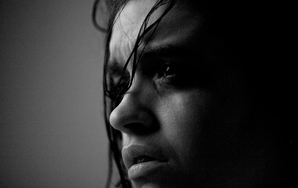On Crying
Human beings are obsessed with the physiological act of crying to an extent so broad that our obsession has pervaded all of our media and language subliminally. Whether or not a given medium can induce tears is often, rationally or otherwise, the benchmark of that medium’s quality or its social relevance; for good or for…

Crying, as it is commonly called, is an act in which human beings engage on a generally-involuntary basis for a purpose the evolutionary function of which one can only guess. Relatively few individuals, excepting especially manipulative people and/or professional actors, consider crying an act of will or a behavior in which one can intentionally engage – or, more specifically, intentional crying usually feels oddly incorrect, like a wall with an obvious hole.
Human beings are obsessed with the physiological act of crying to an extent so broad that our obsession has pervaded all of our media and language subliminally. Whether or not a given medium can induce tears is often, rationally or otherwise, the benchmark of that medium’s quality or its social relevance; for good or for ill tears are often used to define gender roles. A person may be instantaneously moved to regret their words or actions upon being confronted with crying, whereas just a half-moment earlier prior to the emergence of the first tear they felt decisively dispassionate.
As children we are educated on emotional shorthand. Two dots and a great upturned bow – a smile – means ‘happy’, a red face whose brows converge upon themselves suggest anger, and ‘sad’ is usually illustrated via a frowning face decorated with a large blue teardrop. The teardrop is drawn in a fashion identical to the fashion in which children or materials intended for consumption by children illustrate rain. This is a state of being, say crayon pictures, where water is falling.
Perhaps this is why, despite the fact that there is no reason that a sunny day should logically allow an individual more positive opportunity or good sentiment than a day in which it is raining – or, more specifically, the weather is only conjoined to an individual’s chances of having a good day to the extent to which they believe it is – rainy days are associated with ‘blue’ moods. Children see pictures of drops falling and their minds ingrain a permanent, liquid-blue spectrum of sadness, ‘poor’ weather, falling drops and unhappy days.
Notably, however, crying is not necessarily correlated to sadness in particular. If an individual were to attempt to summon in memory the last time he or she shed tears, it is quite possible that rather than sadness there were an equal possibility of one of the following causes: exhaustion, stress, overwhelm, happiness, relief, emotional instability and/or chemical imbalance [possibly due to an incorrect dosage of one or more psychotropic medications should the condition apply]. In fact, it seems any one of the preceding sentiments is an equally-likely precursor to tears as sadness.
Further, many individuals have reported [note: ‘reported’ solely via apocryphal/empirical evidence for the purposes of this article] that genuine sadness, the sort which plows below the troughs of disappointment and loneliness into deep and abiding pain, is tearless; individuals suffering from such severe sadness report that they ‘cannot’ cry or they ‘wish they could’ cry. Their information suggests the act of crying is somehow cathartic, then, that despite being an expression of intense emotion crying serves the purpose of alleviating that intensity, the way that calculated steam ventilation stabilizes a nuclear reactor.
‘How many times a week do you cry’ is a question often asked by people’s therapists and/or on Facebook quizzes as if the answer would give the asker any information on the subject from which to extrapolate. Most people have little to no control over the frequency with which they cry; whether they are rare or frequent cryers, an ‘episode’ of weeping generally appears to well out of nowhere independent of the subject’s will, beginning with a vague aura commonly manifested as warmth or heat about the eyes and cheeks, possibly ears.
The sensation of heat is often followed by a tightening or perceived ‘thickening’ in the throat muscle; like an element more malleable when made hot, the facial muscles can often be perceived to ‘crumple’ as if suddenly yielding to a resistant force, wrinkles in spaces such as the forehead or the ‘parenthesis’ to either side of the nose are more sensitive than usual, more overt.
None of this is voluntary; similarly, neither is the ‘flattening’ of the breath at the back of the mouth nor the way it wants to move faster and faster over the nape of the tongue, to strain the Eustachian canals, an airspace that wants to hook its fingers into one’s throat and into the space behind what is commonly called the ‘windpipe’, tautly. It is somewhat like tension mounting in advance of a sneeze or an orgasm, but in the previous two cases, a subliminal physical urge longs for the release of that tension, whereas in the case of crying there is often the sense of ‘fighting’, like the unshed tears create strain in argument to human will, and that liquid only boils over from the eyes once there is no further resistance to be staged.
There is no precise equation to explicate how many tears must be shed, or what volume of liquid should be expelled from the eyes to ventilate a given quantity of emotional angst, and whether how much uneven breathing/sobbing/gasping is performed in conjunction with the water-shedding [see also: weeping] affects the rate of catharsis. In any event, after launching into the act of tears individuals generally report feeling ‘better’ after crying, even immediately after having engaged in an expression of emotion so intense they could be seen as a saturated towel in need of wringing; they have been wrung, they feel better.
Of course, there are numerous approaches to the act of crying and numerous exceptions to the rules laid out herein, and therefore here are some empirically-calculated examples of the types of crying one can do that notably exclude legitimate reasons to cry, such as physical injury, unexpected death of a loved one, or reasonable extreme circumstances,
Melodramatic Crying. Individual is aware of feeling aggrieved, disadvantaged or victimized; awareness of the perceived condition comes far prior to the urge to be genuinely upset. The primary sentiments include frustration, humiliation and/or an intellectual interpretation of the facts at hand that lead the individual to conclude that he or she has been wronged. The individual feels vaguely aware that crying would be the appropriate response; in advanced cases, the individual is aware that crying would be the ideal route to inflicting guilt upon their aggressor or toward otherwise regaining power in the situation or, failing power, to feel attractive in being wounded. Mentally, the individual applies hard pressure to the sensation of being aggrieved or panicked until they shed tears and the resulting escalation of conflict allows them enough emotional fuel to continue crying until they feel relieved.
Emo Crying. Individual’s mood is generally informed by tangential/ malleable/ unnecessary things, such as sad songs or abstract gazes; individual is liable to be aware on an intellectual level that every practical matter in their life is in at least acceptable order and that they have no material reason to feel hopeless or unfortunate. This particular sort of crying emerges from dwelling on a poorly-defined sense of loss, potentially pertaining to one’s childhood, family or romantic relationship(s), and is then enforced by music, imagery, conversation, alcohol consumption or other stimulus that results in the individual sitting up in bed at 2:35 AM playing ‘Daysleeper’ by R.E.M. while crying and remembering/ loving/ fearing things until they become tired.
Helpless Crying. Individual has persisted in a condition of low-grade stress for some time, and more often than not has been aware of the urge to cry lurking physically at the temple-bones or in the peripheral vision, threatened periodically by uneven dapples of bated breath at even minor stimuli such as a dearly-wanted book being ‘out’ at the library or at someone admired being slightly dismissive. An episode of Helpless Crying is generally triggered by a minor but absolute event, such as dropping a just-purchased sandwich face-down on the floor in front of everyone; accidentally breaking a glass; being unable to reach something important despite a hard stretch of the shoulder and elbow joint; finding that one has made the trip ‘all the way’ to a store or restaurant only to realize one has left one’s wallet behind. This culminates in a quiet and vulnerable-feeling sense of ‘fuck it’ during which one simply capitulates to the urge to cry in public for a short episode, until one has ‘talked’ oneself into a calmer condition. ![]()




